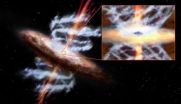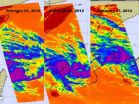(Press-News.org) Fairbanks, Alaska -- On Saturday, Feb. 18 at 8:41 p.m. Alaska time, scientists launched a NASA sounding rocket from Poker Flat Research Range into a brilliant aurora display. The rocket mission, designed to gather information on space weather conditions that affect satellite communications, was a success.
"It was a terrific aurora, the rocket worked great, the instruments worked great and the supporting radar (at Poker Flat) worked wonderfully," said Steve Powell of Cornell University, the principal investigator for the launch. "We achieved all of our objectives. We're ecstatic over the results and our graduate students can't wait to sink their teeth into the data."
After monitoring satellites earlier Saturday that showed an abundance of charged particles coming from the sun and streaming toward Earth's magnetic field, members of the rocket team, which included University of Alaska Fairbanks researchers and personnel from NASA's Wallops Flight Facility in Virginia, were prepared for a night of vigorous aurora. With clear skies at Poker Flat and also at the villages of Fort Yukon and Venetie, where they had narrow-field cameras aimed toward the sky, the scientists opened their launch window at 8 p.m. They watched the aurora dance directly overhead at Poker Flat, waited until the aurora was perfect over Fort Yukon and then launched the two-stage rocket.
In the 10 minutes, 25 seconds it took for the rocket to arc to a high point 200 miles above Venetie to the payload's landing in northern Alaska, a complicated array of antennas deployed, and the rocket both gathered and then transmitted an immense amount of information back to Poker Flat.
"We got a CD of data in our pockets the same night," Powell said. Graduate students at Cornell University, the University of New Hampshire, Dartmouth College and the University of Oslo will use the data as part of their doctoral studies. Their goal is to better model Earth's upper atmosphere and discover more about how space weather affects satellite communications we use every day.
The launch is the first and final one from Poker Flat Research Range this spring. Technicians from the range are today searching for the two rocket motors used to propel the mission. A few days after its launch, Powell was at Poker Flat marveling how the launch went.
"So many things have to come together to have a mission success, and we had them all Saturday night."
Poker Flat Research Range is the largest land-based sounding rocket range in the world and is located 30 miles north of Fairbanks on the Steese Highway. The UAF Geophysical Institute operates the range under contract to NASA. More than 300 major scientific sounding rockets have launched from the facility since it was founded in 1969.
###ADDITIONAL CONTACTS: Steve Powell, Cornell University, 607-227-8421. Poker Flat Research Range: 907-455-2110.
NOTE TO EDITORS: A photo of the launch in available for download at www.uafnews.com.
ADDITIONAL CONTACTS: Steve Powell, Cornell University, 607-227-8421. Poker Flat Research Range: 907-455-2110. Marmian Grimes, UAF public information officer, at 907-474-7902 or via e-mail at marmian.grimes@alaska.edu.
Rocket launches from Poker Flat Research Range
2012-02-29
ELSE PRESS RELEASES FROM THIS DATE:
Ultra-fast outflows help monster black holes shape their galaxies
2012-02-29
A curious correlation between the mass of a galaxy's central black hole and the velocity of stars in a vast, roughly spherical structure known as its bulge has puzzled astronomers for years. An international team led by Francesco Tombesi at NASA's Goddard Space Flight Center in Greenbelt, Md., now has identified a new type of black-hole-driven outflow that appears to be both powerful enough and common enough to explain this link.
Most big galaxies contain a central black hole weighing millions of times the sun's mass, but galaxies hosting more massive black holes also ...
Research sheds light on how immune system's 'first responders' target infection
2012-02-29
University of Texas Medical Branch at Galveston researchers have discovered previously unsuspected aspects of the guidance system used by the body's first line of defense against infection.
The new work focuses on the regulation of immune response by two forms of the signaling molecule IL-8, as well as IL-8's interaction with cell-surface molecules called glycosaminoglycans (or GAGs for short).
Infected or injured tissues release IL-8 to attract bacteria- and virus-killing white blood cells known as neutrophils, a process known as "recruitment." As IL-8 proteins disperse ...
Upper class more likely to be scofflaws
2012-02-29
The upper class has a higher propensity for unethical behavior, being more likely to believe – as did Gordon Gekko in the movie "Wall Street" – that "greed is good," according to a new study from the University of California, Berkeley.
"The increased unethical tendencies of upper-class individuals are driven, in part, by their more favorable attitudes toward greed," said Paul Piff, a doctoral student in psychology at UC Berkeley and lead author of the paper published today (Monday, Feb. 27) in the journal Proceedings of the National Academy of Sciences.
Piff's study ...
3 days of NASA infrared images show System 92S tropically developing
2012-02-29
NASA satellites have been watching the low pressure area called System 92S for days, and infrared imagery from NASA's Aqua satellite showed cloud temperatures were cooling, indicating the storm was getting more organized after it moved over northern Madagascar. Now it may be headed for landfall in Mozambique.
The Atmospheric Infrared Sounder (AIRS) instrument on NASA's Aqua satellite captured infrared imagery on developing System 92S as it moved from the Southern Indian Ocean, west across northern Madagascar and into the Mozambique Channel. On February 25 at 0941 UTC, ...
Hays Reports Tunnel Vision Trapping Workers and Hindering Growth
2012-02-29
The Hays Career Outlook Survey has revealed that workers are being trapped in career silos because they don't believe they can cross sector or industry boundaries, according to new data from the Hays Career Outlook Survey. The survey also highlights that employers in both sectors are often unable to recognise the transferable skills that might help them to identify potential candidates who are capable of supporting their growth plans.
The survey reveals the vast majority of employers believe that previous experience in the same sector is important. Whilst only just ...
Salty soil can suck water out of atmosphere: Could it happen on Mars?
2012-02-29
CORVALLIS, Ore. – The frigid McMurdo Dry Valleys in Antarctica are a cold, polar desert, yet the sandy soils there are frequently dotted with moist patches in the spring despite a lack of snowmelt and no possibility of rain.
A new study, led by an Oregon State University geologist, has found that that the salty soils in the region actually suck moisture out of the atmosphere, raising the possibility that such a process could take place on Mars or on other planets.
The study, which was supported by the National Science Foundation, has been published online this week ...
Modified bone drug kills malaria parasite in mice
2012-02-29
CHAMPAIGN, Ill. — A chemically altered osteoporosis drug may be useful in fighting malaria, researchers report in a new study. Unlike similar compounds tested against other parasitic protozoa, the drug readily crosses into the red blood cells of malaria-infected mice and kills the malaria parasite. The drug works at very low concentrations with no observed toxicity to the mouse.
The study appears in the Proceedings of the National Academy of Sciences.
The researchers found the drug by screening a library of about 1,000 compounds used in previous efforts to target an ...
Protocol reduces sternal wound infections in children by 61 percent
2012-02-29
SAN ANTONIO -- A two-year effort to prevent infections in children healing from cardiac surgery reduced sternum infections by 61 percent, a San Antonio researcher announced at the Cardiology 2012 conference Feb. 23 in Orlando, Fla.
Faculty from UT Medicine San Antonio carried out a new infection-control protocol for 308 children who underwent sternotomies at CHRISTUS Santa Rosa Children's Hospital between 2009 and 2011. UT Medicine is the clinical practice of the School of Medicine at The University of Texas Health Science Center San Antonio.
Approach to children ...
HFSA updates recommendations for use of cardiac resynchronization therapy
2012-02-29
Philadelphia, PA, February 27, 2012 – Based on a review of the latest evidence, the Guidelines Committee of the Heart Failure Society of America now recommends that the use of cardiac resynchronization therapy (CRT) be expanded to a larger group of patients with mild heart failure symptoms. Recommendations for integrating new evidence into clinical practice appear in the February issue of the Journal of Cardiac Failure.
CRT devices synchronize the function of the left ventricle so that it contracts more efficiently and in a coordinated way. It does this by stimulating ...
Guoman Hotels' The Grosvenor Hotel Victoria Uncovers the 'Courtesan's Boudoir'
2012-02-29
Guoman Hotels' The Grosvenor Hotel has revealed its past connection to one of the most risque residents of 1870s London, with the launch of its opulent 'Courtesan's Boudoir'. The Parisian-inspired Suite has been tenderly created in homage to one of the grand railway hotel's most infamous visitors - the scandalous courtesan, Miss Cora Pearl.
A lady notorious with entertaining only the highest members of social standing, including royalty, Cora Pearl was one of the most feted courtesans of her time. In the 1870s, Cora made a rare visit to London and, after arriving at ...


